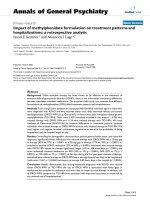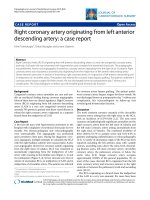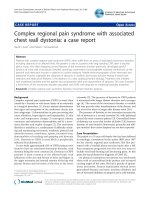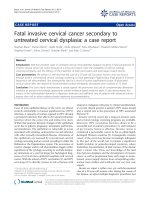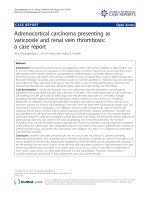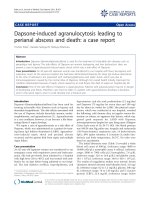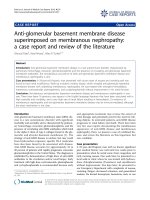Báo cáo y học: " Management of major bile duct injury after laparoscopic cholecystectomy: a case report" pptx
Bạn đang xem bản rút gọn của tài liệu. Xem và tải ngay bản đầy đủ của tài liệu tại đây (552.59 KB, 6 trang )
BioMed Central
Page 1 of 6
(page number not for citation purposes)
Journal of Medical Case Reports
Open Access
Case report
Management of major bile duct injury after laparoscopic
cholecystectomy: a case report
Andreas Manouras
1
, Nikolaos Pararas
1
, Pantelis Antonakis
1
,
Emannuel E Lagoudiannakis*
2
, George Papageorgiou
3
,
Ioannis G Dalianoudis
2
and Manoussos M Konstadoulakis
1
Address:
1
1st Department of Propaedeutic Surgery, Hippocrateion Hospital, Athens Medical School, University of Athens, Athens, Greece,
2
Second
Department of Surgery, 417NIMTS, Athens, Greece and
3
Endoscopic Radiology Department, Naval Hospital of Athens, Athens, Greece
Email: Andreas Manouras - ; Nikolaos Pararas - ;
Pantelis Antonakis - ; Emannuel E Lagoudiannakis* - ;
George Papageorgiou - ; Ioannis G Dalianoudis - ;
Manoussos M Konstadoulakis -
* Corresponding author
Abstract
Introduction: Bile duct injury is a severe and potentially life-threatening complication of
laparoscopic cholecystectomy. Several series have described a 0.5% to 0.6% incidence of bile duct
injury during laparoscopic cholecystectomy. The aim of this study was to analyze the presentation,
characteristics, related investigation, and treatment results of major bile duct injuries after
laparoscopic cholecystectomy.
Case presentation: A rare case of a 48-year-old Greek woman with a triple bile duct injury (right
and left hepatic duct ligation and common bile duct cross-section) is presented. A Roux en Y
hepaticojejunostomy was performed after repeated endoscopic retrograde
cholangiopancreatographies, percutaneous transhepatic catheterization of the ducts and magnetic
resonance cholangiographies to delineate the biliary anatomy and assess the level of injury.
Conclusion: Early recognition and an adequate multidisciplinary approach are the cornerstones
for the optimal final outcome. Suboptimal management of injuries often leads to more extensive
damage to the biliary tree and its vasculature. Early referral to a tertiary care center with
experienced hepatobiliary surgeons and skilled interventional radiologists would appear to be
necessary to assure optimal results.
Introduction
Gallstone disease is one of the most common digestive
health problems [1]. Laparoscopic cholecystectomy (LC)
is now the gold standard for gallbladder removal in the
management of symptomatic cholelithiasis with
decreased postoperative morbidity and mortality. Still,
bile duct injuries are reported to be more severe and more
common when compared to open cholecystectomy [2-5]
with a reported incidence of up to 0.6% for laparoscopic
versus 0.1% for open cholecystectomy [5]. These injuries
Published: 31 January 2009
Journal of Medical Case Reports 2009, 3:44 doi:10.1186/1752-1947-3-44
Received: 21 May 2008
Accepted: 31 January 2009
This article is available from: />© 2009 Manouras et al; licensee BioMed Central Ltd.
This is an Open Access article distributed under the terms of the Creative Commons Attribution License ( />),
which permits unrestricted use, distribution, and reproduction in any medium, provided the original work is properly cited.
Journal of Medical Case Reports 2009, 3:44 />Page 2 of 6
(page number not for citation purposes)
are a disaster for both the patient and the surgeon because
of the associated morbidity, prolonged hospitalization,
and mortality [6].
The management of patients following major bile duct
injury is a surgical challenge often requiring the skills of
experienced hepatobiliary surgeons at tertiary referral
centers [7]. Collaboration among surgeons, gastroenterol-
ogists and interventional radiologists is imperative in the
care of such injuries.
The aim of this study was to analyze the presentation,
characteristics, related investigation, and treatment results
of a case with major complex bile duct injury after LC.
Case presentation
A 48-year-old Greek female patient was referred to our
institution for the management of biliary trauma after
laparoscopic cholecystectomy. In her medical history, she
had had two laparotomies: an ileoanal anastomosis with
j pouch for ulcerative colitis 15 years ago, while 5 years
ago she was driven to the operating room after a colonos-
copy for peritonitis. Due to non-specific upper gastroin-
testinal symptoms she had had an upper abdominal
ultrasound (US) that revealed cholelithiasis (at least two
gallstones of diameter 0.8 and 0.7 cm) 2 months before
surgery and elective laparoscopic cholecystectomy was
performed 18 months before her referral to us.
The duration of laparoscopic cholecystectomy was 150
minutes while the procedure was completed laparoscopi-
cally and there is no record of intraoperatively identified
biliary injury. From the 2nd postoperative day and up to
her referral to our institution, recurrent episodes of
cholangitis with severe pain, fever with chills and jaundice
began. Magnetic resonance cholangiography (MRC) was
performed in order to delineate the biliary anatomy and
assess the level of injury. A triple bile duct injury, with
right and left hepatic duct ligation and common bile duct
cross-section, was revealed (Bismuth type V, Figure 1).
Attempts at permanent biliary decompression with
repeated endoscopic retrograde cholangiopancreatogra-
phies (ERCP), combined with percutaneous transhepatic
duct catheterization failed and for 1 year postoperatively
bile drained from abdominal drains. On the 13th postop-
erative month, she was referred to another hospital for bil-
iary draining (Figure 2). Through the left drain, a
guidewire was passed only to be found later during ERCP
in the duodenum in a place other than the papilla of Vater
via a false route. On the next episode of cholangitis, both
left and right biliary trees were successfully decompressed
and 18 months after LC, she was referred to our hospital
for surgical reconstruction.
The intraoperative findings were as follows: the hepatic
duct was cut and double ligated with clips, the right ante-
rior hepatic duct was closed with an endo-clip, the right
posterior hepatic duct was cut and ligated with one endo-
clip, the left hepatic duct was cut and had a catheter pass-
ing through a partially open clip via a false route to the
duodenum while the right hepatic artery was clip-ligated
A triple bile duct injury, with right and left hepatic duct liga-tion and common bile duct cross-section (Bismuth type V), was revealed in magnetic resonance imagingFigure 1
A triple bile duct injury, with right and left hepatic
duct ligation and common bile duct cross-section
(Bismuth type V), was revealed in magnetic reso-
nance imaging.
Percutaneous decompression of both left and right biliary ducts was successfulFigure 2
Percutaneous decompression of both left and right
biliary ducts was successful. A false route was created to
the duodenum through partial opening of the left duct clip
from the guidewire.
Journal of Medical Case Reports 2009, 3:44 />Page 3 of 6
(page number not for citation purposes)
as well. After partial resection of segment IV of the liver,
extensive dissection of the biliary tree was performed and
then a plastic reconstruction of all major right hepatic
ducts to a "common" right hepatic duct was performed
with PDS 6-0. Finally, Roux en Y hepaticojejunostomy of
both the newly formed common right hepatic duct and
the left hepatic duct was performed at separate sites. The
catheter in the left hepatic duct was left in place while the
one in the right hepatic duct was removed. Three months
after the operation, cholangiography showed patency of
the left and right hepatic ducts (Figure 2) and after
removal of the remaining stent, the patient has had no
complaints. The liver function tests have so far returned
results within the normal limits.
Discussion
Biliary injuries include biliary leakage, hemobilia, and bil-
iary fistula. The pattern of bile duct injuries has changed
or become more complicated in recent years. There have
been a few proposals to classify postoperative strictures
and bile duct injuries. The Corlette-Bismuth classification
(Table 1) is based on the length of the proximal biliary
stump but not on the nature and length of the lesion. A
detailed subdivision into minor and major bile duct inju-
ries has been proposed by McMahon. Minor injuries
include laceration of the cystic to common bile duct junc-
tion and laceration of the common hepatic duct over less
than 25% of the duct diameter. Major injuries include lac-
eration over more than 25% of the bile duct diameter,
transection of the common hepatic or common bile duct,
or the development of postoperative stricture. Another
classification is by Strasberg (Table 2), and this is the most
detailed classification as all types of injury, including
leaks can be classified [3]. It is quite difficult to obtain the
exact incidence rate of iatrogenic bile duct injuries because
bile duct injuries can be attributable to the negligence of
surgeons and are sometimes deliberately evaded in the
hospital records, where these injuries are referred to as
anatomical abnormalities or agenesis of the gallbladder
[8].
The treatment of patients with major bile duct injury
(MBDI) after LC is a difficult problem and depends on the
time of diagnosis after the initial injury and the type,
extent and level of the injury. The aim of the treatment is
immediate management of the associated sepsis, fistula,
and obstruction of the biliary system. Identification and
categorization of the type of MBDI are the next steps.
Once this is done, definitive repair of the injury should be
performed. Postoperative follow-up and guidance, are
vital parts of this prolonged treatment protocol. The
reported incidence of MBDI after laparoscopic cholecys-
tectomy has been shown to be higher than that after open
cholecystectomy [9]. Several risk factors have been identi-
fied, mainly dangerous pathology, dangerous anatomy,
and dangerous surgery [10]. In spite of the recognition of
these well established risk factors, MBDI continues to be a
problem in laparoscopic surgery. Furthermore, it may be
missed during laparoscopic cholecystectomy [11].
During cholecystectomy, much emphasis is given to com-
plete exposure of the operating area. During the exposure
of peritoneal attachments in Calot's triangle, anatomical
variations should be clearly identified, and the cystic duct
should not be separated until the junction of the common
hepatic and cystic ducts is positively identified. There is no
confluence of any other abnormal ducts into the cystic
duct.
Sometimes the anatomical structure of Calot's triangle is
not very clear because of congestion, edema and fragility
of the tissues around the cystic duct in acute suppurative
or gangrenous cholecystitis. Fibrous tissue scars are often
formed in Calot's triangle in atrophic cholecystitis. It is
more difficult to avoid intraoperative bile duct injuries
(IBDI) in such conditions, when correct identification of
Calot's triangle is less likely.
Injuries to the bile duct system during laparoscopic chole-
cystectomy are an unaltered cause for concern not neces-
sarily related to the "learning curve" of the operating
surgeon as suggested in the past [12]. In recent studies, it
was demonstrated that in more than one-third of all bile
duct injuries, the basic cause of error is not the inexperi-
ence of the surgeon but the use of an improper approach
to the fundamental structures of the extrahepatic biliary
tree because of a visual perceptual illusion [12]. Corre-
spondingly, in most cases, the problem is not recognized
at the time of the initial procedure, particularly in the
presence of acute inflammation or chronic fibrosis. The
role of intraoperative cholangiography and laparoscopic
ultrasonography in prevention of MBDI during laparo-
scopic cholecystectomy is a matter of ongoing debate
[13].
Table 1: Corlette-Bismuth classification
Type 1 Low common hepatic duct stricture, with a length of the common hepatic duct stump of > 2 cm
Type 2 Middle stricture: length of common hepatic duct < 2 cm
Type 3 Hilar stricture, no remaining common hepatic duct, but the confluence is preserved
Type 4 Hilar stricture, with involvement of confluence and loss of communication between right and left hepatic duct
Type 5 Combined common hepatic and aberrant right hepatic duct injury, separating from the distal common bile duct
Journal of Medical Case Reports 2009, 3:44 />Page 4 of 6
(page number not for citation purposes)
Proper diagnosis and appropriate treatment of MBDI, are
paramount in preventing life-threatening complications
of cholangitis, biliary cirrhosis, portal hypertension, end-
stage liver disease, and death. At the time of referral, all
patients with suspected bile duct injury should undergo
US and computed tomography (CT) so that any dilatation
or fluid collection can be found. Those techniques must
be combined with magnetic resonance cholangiopancrea-
tographies (MRCP), ERCP or percutaneous transhepatic
catheterization (PTC) in order to delineate the biliary
anatomy [3]. All patients who do not recover immediately
after cholecystectomy by definition are candidates for
having a bile duct injury. Those patients should follow the
proposed flow diagram as depicted in Figure 3. Early refer-
ral to tertiary care centers with expertise in biliary surgery
may limit further operations, complications, time to
definitive repair, and mortality.
Table 2: Strasberg classification
Type A Bile leak from cystic duct or liver bed without further injury
Type B Partial occlusion of the biliary tree, most frequently of an aberrant right hepatic duct
Type C Bile leak from duct (aberrant right hepatic duct) that is not communicating with the common bile duct
Type D Lateral injury of biliary system, without loss of continuity
Type E Circumferential injury of biliary tree with loss of continuity
Suggested flow diagram for patients with suspected bile duct injury after laparoscopic cholecystectomy [3]Figure 3
Suggested flow diagram for patients with suspected bile duct injury after laparoscopic cholecystectomy [3].
Journal of Medical Case Reports 2009, 3:44 />Page 5 of 6
(page number not for citation purposes)
Pre-operative imaging studies such as magnetic resonance
cholangiographies (MRC), ERCP, and PTC correctly delin-
eate the location and nature of MBDI [3,14]. Surgery
should only be contemplated when the patient is stabi-
lized and the MBDI has been correctly classified. The suc-
cess of the operating procedure depends directly on the
proper and accurate delineation of the MBDI. If the injury
is recognized in the early postoperative period (2 to 7
days), involves a relatively distal lesion below the bifurca-
tion and is not associated with biliary leakage, abscess for-
mation and sepsis, early reconstruction can be considered.
When we have involvement of the bifurcation, percutane-
ous biliary drainage is preferred with elective repair after 6
to 8 weeks [3]. The control of sepsis and the ongoing bile
leak are the primary goals of the initial management of a
bile duct injury. If this can be accomplished, proceeding
with surgical reconstruction is not urgent. In fact, recon-
struction in the face of peritonitis portends a statistically
poorer outcome in patients.
Once the sepsis and leaks have been controlled and the
MBDI is classified, a hepaticojejunostomy should be con-
structed to a Roux-en-Y jejunal limb, or less commonly an
end to side Roux-en-Y choledochojejunostomy. Satisfac-
tory results have been reported by many authors using the
Roux-en-Y hepaticojejunostomy. For strictures involving
the bifurcation of left or right hepatic ducts, bilateral
hepaticojejunostomies may be necessary. Level of injury is
an important factor; the greater the level of the injury, the
poorer the outcome after the procedure. Other factors
include the timing of the repair, the performance of pre-
operative cholangiography, the choice of surgical proce-
dure, the expertise of the surgeon performing the repair,
and the presence of concomitant vascular injury [11].
There are no data in the literature to show the exact inci-
dence of recurrent stricture requiring revision hepaticoje-
junostomy after LC. In this situation, the level of the
anastomosis is always greater than the original one. As
reported in the literature, the outcome of surgical recon-
struction mainly for major lesions or failure of endoscopic
treatment is dependent on the timing of the reconstruc-
tion [3]. Postoperatively, as we can see from the literature,
the transhepatic catheters should stay for external gravity
drainage until day 5 when a cholangiogram should be
performed. If no leaks or strictures are detected the tran-
shepatic catheters should be capped (internalized). Fol-
low-up cholangiograms should be obtained at 1 and 3
months postoperatively except if otherwise indicated.
Catheters should be removed between 3 and 6 months
postoperatively depending on the level of the injury and
appearance of the cholangiogram [9]. After open chole-
cystectomy, recurrent biliary stricture has been observed
in 10–30% of cases [15]. Moreover, patients with recur-
rent stricture are at higher risk of developing further reste-
nosis. The number of previous surgical attempts also
greatly influences the outcome. With repeated attempts to
correct the failed repair, the stricture becomes ever greater,
making the next repair even more difficult and the result
even more unpredictable. To avoid these problems, it has
been argued that patients with MBDI after LC should
always be referred to a specialist center and that any
attempts at repair outside tertiary units should be discour-
aged.
Conclusion
In summary, MBDI after LC is a major problem that
requires a multidisciplinary approach at a tertiary level
center. Sepsis, biliary leaks, and collections should be
managed appropriately, and proper classification of the
MBDI via imaging needs to be done before the surgical
repair. Roux-en-Y hepaticojejunostomy yields excellent
results in these cases. Life-threatening complications can
occur as a result of delayed referral or, rarely, after surgical
repair. Although overall complications are frequent,
almost all can be managed non-operatively. These data
support the concept of early referral to a tertiary care
center with experienced hepatobiliary surgeons and
skilled interventional radiologists to assure optimal short-
term and long-term outcomes.
Abbreviations
CT: computed tomography; ERCP: endoscopic retrograde
cholangiopancreatography; LC: laparoscopic cholecystec-
tomy; PTC: percutaneous transhepatic cholangiography;
US: ultrasound; IBDI: intraoperative bile duct injuries;
MRC: magnetic resonance cholangiography; MBDI: major
bile duct injuries
Competing interests
The authors declare that they have no competing interests.
Authors' contributions
<Author: From the BioMed guidelines, authors IGD,
MMK and VK don't seem to qualify as authors. An
"author" is generally considered to be someone who has
made substantive intellectual contributions to a pub-
lished study. To qualify as an author one should 1) have
made substantial contributions to conception and design,
or acquisition of data, or analysis and interpretation of
data; 2) have been involved in drafting the manuscript or
revising it critically for important intellectual content; and
3) have given final approval of the version to be pub-
lished. Each author should have participated sufficiently
in the work to take public responsibility for appropriate
portions of the content. Acquisition of funding, collection
of data, or general supervision of the research group,
alone, does not justify authorship. All contributors who
do not meet the criteria for authorship should be listed in
an acknowledgments section. Examples of those who
might be acknowledged include a person who provided
Publish with BioMed Central and every
scientist can read your work free of charge
"BioMed Central will be the most significant development for
disseminating the results of biomedical research in our lifetime."
Sir Paul Nurse, Cancer Research UK
Your research papers will be:
available free of charge to the entire biomedical community
peer reviewed and published immediately upon acceptance
cited in PubMed and archived on PubMed Central
yours — you keep the copyright
Submit your manuscript here:
/>BioMedcentral
Journal of Medical Case Reports 2009, 3:44 />Page 6 of 6
(page number not for citation purposes)
purely technical help, writing assistance, or a department
chair who provided only general support. After all authors
meeting they have decided that IGD and MMK should be
included to the authors as they have played an impor-
taned role to the manuscript conception and they agree
that VK should be listed in the acknowledgement section>
AM carried out the operation and contributed to acquisi-
tion of consent and critical review of the manuscript. NP,
PA, EEL and GP all contributed to manuscript conception,
research, acquisition of data, drafting and writing of the
manuscript. IGD contributed to research, organizing,
drafting, and writing of the manuscript. MMK contributed
to writing of the manuscript. All authors read and
approved the final manuscript.
Consent
Written informed consent was obtained from the patient
for publication of this case report and any accompanying
images. A copy of the written consent is available for
review by the Editor-in-Chief of this journal.
Acknowledgements
VK contributed to organizing and drafting of the manuscript.
References
1. Nakeeb A, Comuzzie AG, Martin L, Sonnenberg GE, Swartz-Basile D,
Kissebah AH, Pitt HA: Gallstones: genetics versus environment.
Ann Surg 2002, 235:842-849.
2. Sicklick JK, Camp MS, Lillemoe KD, Melton GB, Yeo CJ, Campbell KA,
Talamini MA, Pitt HA, Coleman J, Sauter PA, Cameron JL: Surgical
management of bile duct injuries sustained during laparo-
scopic cholecystectomy: perioperative results in 200
patients. Ann Surg 2005, 241:786-795.
3. Rauws EA, Gouma DJ: Endoscopic and surgical management of
bile duct injury after laparoscopic cholecystectomy. Best Pract
Res Clin Gastroenterol 2004, 18:829-846.
4. Ponsky JL: Complications of laparoscopic cholecystectomy.
Am J Surg 1991, 161:393-395.
5. Deziel DJ, Millikan KW, Economou SG, Doolas A, Ko ST, Airan MC:
Complications of laparoscopic cholecystectomy: a national
survey of 4,292 hospitals and an analysis of 77,604 cases. Am
J Surg 1993, 165:9-14.
6. Kaman L, Behera A, Singh R, Katariya RN: Management of major
bile duct injuries after laparoscopic cholecystectomy. Surg
Endosc 2004, 18:1196-1199.
7. Branum G, Schmitt C, Baillie J, Suhocki P, Baker M, Davidoff A, Branch
S, Chari R, Cucchiaro G, Murray E, Pappas T, Cotton P, Meyers WC:
< Author: Please check author names. Seems to be an error
just before Pappas. yes, you where right, I have corect the
mistake >: Management of major biliary complications after
laparoscopic cholecystectomy. Ann Surg 1993, 217:532-541.
8. Etala E: Surgery of the biliary tract. In Atlas of Gastrointestinal Sur-
gery Baltimore: Williams & Wilkins; 1997:222-290.
9. Johnson SR, Koehler A, Pennington LK, Hanto DW: Long term
results of surgical repair of bile duct injuries following lapar-
oscopic cholecystectomy. Surgery 2000, 128:668-677.
10. Richardson MC, Bell G, Fullarton GM: Incidence and nature of
bile duct injuries following laparoscopic cholecystectomy: an
audit of 5913 cases. West of Scotland Laparoscopic Chole-
cystectomy Audit Group. Br J Surg 1996, 83:
1356-1360.
11. Lillemoe KD, Martin SA, Cameron JL, Yeo CJ, Talamini MA, Kaushal
S, Coleman J, Venbrux AC, Savader SJ, Osterman FA, Pitt HA: Major
bile duct injuries during laparoscopic cholecystectomy: fol-
low-up after combined surgical and radiological manage-
ment. Ann Surg 1997, 225:459-468.
12. Archer SB, Brown DW, Smith CD, Branum GD, Hunter JG: Bile
duct injury during laparoscopic cholecystectomy. Results of
a National Survey. Ann Surg 2001, 234:549-559.
13. Biffl WL, Moore EE, Offner PJ, Franciose R, Burch JM: Routine intra-
operative laparoscopic ultrasonography with selective
cholangiography reduces bile duct complications during
laparoscopic cholecystectomy. J Am Coll Surg 2001, 193:272-280.
14. Csendes A, Diaz JC, Burdiles P, Maluenda F: Later results of imme-
diate primary end to end repair in accidental section of the
common bile duct. Surg Gynecol Obstet 1989, 168:125-130.
15. Pelligrini CA, Thomas MJ, Way LW: Recurrent biliary stricture:
pattern of recurrence and outcome of surgical therapy. Am J
Surg 1984, 147:175-180.
